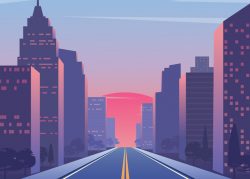Any good designer thinks long and hard not only about the details for their product but the entire user experience around it. The commercial real estate industry’s product is obviously the buildings where we work but the user experience of these spaces includes how we get to and from them. The pride and joy of most American cities, the central business districts (or CBDs), have been walloped by Covid-19. Their two main activity generators, white collar employment and hospitality, disappeared almost overnight. Many are experiencing closures and restrictions on the restaurants and shops that gave them their draw.
Read more


With vaccines arriving and probably about six months away from widespread deployment, CBD employment and travel will soon start their rebuilding phase. But while remote work and virtual meetings are potentially a drag on the return to downtown, a bigger threat to the market health of some of America’s largest cities is service cuts in public transit.
Transit was one of the most Covid-affected public services. In a reversal of recent patterns, it was America’s large, superstar cities that were the hardest hit. In most American cities, transit has very low commute mode share, and operates as a de facto social service. Even in cities like Dallas, most white-collar downtown office workers commute by car. So in most cities the value of downtown real estate is not especially dependent on public transit.
Things are very different in cities like New York, San Francisco, Chicago, Boston, and Washington. In these cities, public transit is used by a wide cross-section of the community, not just the poor. And a large percentage of downtown workers commute by transit. Due to congestion, choke points like bridges, and a lack of parking, it is not feasible for transit use to be replaced with car trips. There are not enough lanes of highways to possibly accommodate all the commuters, and not nearly enough parking spaces for their cars. Even if it were possible to build enough parking garages in these cities for most people to drive, that would be a very undesirable thing to do. These cities thrive on the density that comes from building skyscrapers that do not have any parking attached to them. If they started to be built similar to smaller, less dense cities, where downtown high rises frequently sit on large parking pedestals or next to attached garages, that would significantly attenuate their levels of urban activity and attractiveness. These cities need transit to function well and maintain the activity that comes from urban density.
In these very large cities, transit ridership took a much bigger hit than in smaller cities, simply because so many white-collar workers commute by transit. Commuter rail systems in particular were hard hit. Chicago’s Metra suburban commuter rail system saw a ridership decline of 97 percent at peak.
These cities also very heavily depend on fare revenue to fund operations. The Chicago Transit Authority, for example, raises half or more of its operating budget from fares. In smaller cities with less ridership, the financing structure of transit typically only includes 20 to 25 percent or less of the budget from fares. While tax subsidies or state revenue sharing may be impaired by Covid-19, the loss of fare revenue has created an immediate financial crisis for many larger transit systems.
The New York MTA is an example. It had an estimated $14 billion budget shortfall from Covid-19 related impacts. The federal CARES Act from last year provided temporary support to transit agencies, and this was recently extended through recent Congressional action. But if ridership remains depressed for an extended period of time, this will continue pressuring budgets and service levels.
The reality is that central business district employment is likely to be depressed for some time. Economist Richard Florida, who foreshadowed the rise of the superstar city economy in his 2002 book The Rise of the Creative Class, estimates a longer-term potential 20 to 30 percent decline in employment in American downtowns. This will be a hit to transit ridership. Historically, extended strikes have also taken a longer-term toll on ridership. It took a decade or more for ridership to recover after a commuter rail strike in Philadelphia in the early 1980s, for example. So this effect might also be a drag on ridership recovery, since Covid-19’s impact has been a strike-like disruption.
Even with a significant near-term federal aid package for transit, will the federal government be willing to subsidize underutilized pre-Covid-19 levels of service for years? If not, and state and local tax increases don’t cover the gap, service cuts will happen. And history suggests that it’s very difficult to restore service cuts after they happen. New York City has already ended overnight subway service to enable deep cleaning of transit. Will that ever return?
Any reductions in transit service directly reduces the attractiveness of central business districts as a place to work and do business, which in turn reduces real estate values. The desirability of Midtown Manhattan, the Chicago Loop, or the San Francisco Financial District depends heavily on the ability to commute there conveniently by public transit. Even with hybrid working and a “hub and spoke” office location strategy, downtown headquarters will likely still play a large role in many occupiers’ real estate plans.
Local leaders who want to rebuild the economy of their central city and preserve its real estate values need to work hard to ensure that they maintain as much of their transit levels as possible, something that is going to be a major challenge, most likely for years. While this might fall out of the traditional purview of the designers, owners, and operators of office buildings, it is certainly part of their product’s overall experience. The bottom line is that if we want to convince people to come back to the office, we have to create safe, reliable, and sustainable ways for them to get there. [Propmodo]
